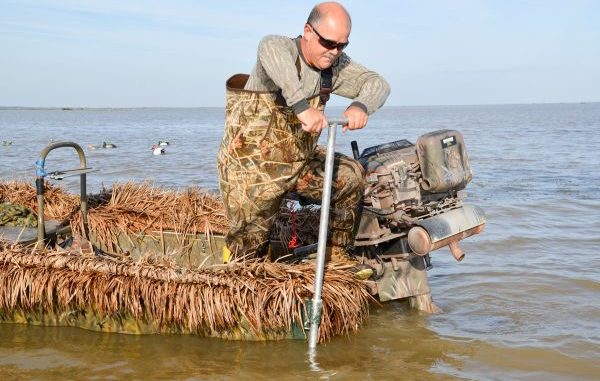
Little things make big differences in all hunting.
Let’s face it: Hunters who succeed time after time — as well as those that don’t — do 99 percent of everything the same. They get up at the same time, shoot the same guns, wear the same clothes, hunt the same areas and use the same calls and attractants.
But certain people always seem to do better than others.
While neither man discounts other factors, Pat Attaway and John Dupuis believe much of their success in using a pop-up boat blind comes from their modifications to the boat and the blind.Some of their modifications are major, while others are minor. Here’s a few of the changes they make.
Spudding in
A stable shooting platform is critical, Attaway said. Rocking boats make hunters miss, and every move by hunters in the boat makes unnatural waves that move out from the boat.
While they may not be overtly noticeable to the hunters, the waves are obvious from the air. Also, in open water, wind-driven waves, even small ones, rock the boat.
Some hunting boats are not equipped with spuds and spud sockets, while most of those that are have only two sockets. The boat Attaway and Dupuis hunt from has four aluminum sockets welded in place — one on each side of the bow and one on each side of the stern.
More spud poles can easily be fabricated at welding shops.
Spud poles and sockets are typically aluminum. Aluminum is a soft metal, and the friction of aluminum against aluminum without lubrication will cause the metal to “gall,” a phenomenon during which metal particles from the spud and the socket actually become friction-welded to one surface or the other, Dupuis explained.
Their solution is to insert a length of PVC sink tailpiece (available in the plumbing section of any hardware store) into each socket. These effectively provide the lubrication needed to make spudding much easier.
Dupuis also has modified the business end of each spud pole. Rather than having the pointed tip that most spuds come with from the manufacturer, he has had a screwdriver-like tip inserted. In all bottoms, but especially for harder sand and clay bottoms, that tip allows the spud pole to be “hand-augered in.”
Hiding out
Duck hunters are supposed to be masters of camouflage, but all too many take shortcuts. Dupuis and Attaway are meticulous about making sure the metal bow of the boat and the entire motor are hidden by grass mats and palmetto fronds.
Hunters often hide the top of the motor and bow, but neglect the sides; approaching ducks see the side of the boat and motor, as well as their tops.
More importantly, they keep their dogs inside the boat with them, leaving only their heads exposed so they can mark fallen birds. Having dogs sit outside the boat on a box or on the bow is certainly more comfortable for the hunters, but little things matter.
“Are there days where having a dog sit exposed on the bow doesn’t matter?” Attaway asked. “Sure. But there other days where it is critical (to keep the dog hidden).”
Wall details
A factor that all too many hunters overlook on boat blinds is slope of the blind wall, something Attaway feels is critical.
To function at its best in concealing hunters, the blind wall should slope inward toward the centerline of the boat, like a teepee, with just enough opening at the top for hunters to move and shoot, he said.
Hunters feel hidden in a boat with straight, vertical sides because they sit next to the blind wall and peep over it.
“But,” Attaway said, “with straight-up sides, no matter how much material is on the sides, ducks can see down into the blind.”
Factory-built pop-up blind walls have an additional problem the pair easily corrected: Pop-up blind frames are, by necessity, built of lightweight pipe.
The horizontal pipe supporting the 14-foot stretch of blind in their boat sagged several inches in the middle. Inserting a notched 1-inch-by-2-inch board vertically under the pipe both raised the wall and strengthened it, solving the problem of unknowing guest hunters putting their weight on the fragile pipe.
Greening up
One problem boat blinds — pop-up or otherwise — have is that they tend to stick out from their surroundings. Even grass-mat blinds, probably because of their boxy shape tend to look unnatural. And in bright sunlight, the uniform tan-colored grass is almost shiny.
In most applications, except in a completely brown or tan marsh, green is a better color for duck blinds. Many hunters regularly rebrush blinds to add greenery.
Attaway and Dupuis solve a host of problems by dressing their grass mat blind with palmetto fronds. The fronds break up the color and texture of the blind surface, they add greenery, and they provide overhead and facial cover for the hunters.
However, the men are careful with the placement of the palmetto fronds, the stems of which are inserted into the grass and webbing material of their blind. Fronds placed on the front or shooting side of the blind are placed so their tips are at the level of the shooters’ caps to allows them to watch and work birds by looking through gaps in the frond tips.
“It doesn’t create a visibility problem,” Dupuis said, “if you move your head slightly from side to side as you watch for birds. In fact, after a while you don’t even notice the frond tips are there.”
Attaway said palmettos placed on the back side of the blind are set much higher — as high as possible. The drooping tips of those fronds creates overhead cover and puts the hunters in the shadows, reducing face shine and the possibility that movement in the blind will be spotted by the ducks.
Some palmettos are damaged each hunt. Dupuis emphasizes that it is important to keep the blind fresh, so these are discarded at the end of each hunt and replaced with new ones from their stash. Spare palmetto fronds will stay green for a couple of weeks if the cut ends of their stems are kept submersed in water.






